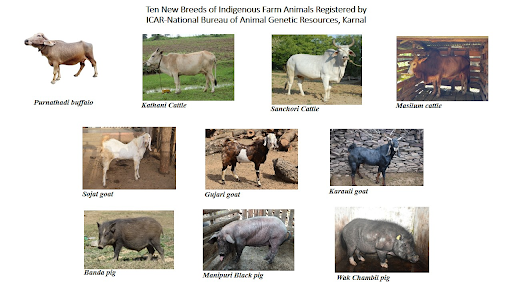In news– Recently, the Indian Council of Agricultural Research (ICAR) has registered 10 new breeds of livestock species, including cattle, buffalo, goat and pig that has taken the total number of indigenous breeds to 212.
About the new species-
- The 10 new breeds included three new cattle breeds (Kathani, Sanchori, Masilum), one buffalo breed (Purnathadi), three goat breeds (Sojat, Karauli, Gujari) and three pig breeds (Banda, Manipuri Black, Wak Chambil).
- Purnathadi buffalo is found in the Vidarbha region of Maharashtra.
- The population of Kathani, a dual purpose cattle, is also distributed in the region. It possesses good draft ability and is suited to marshy land for paddy cultivation.
- Masilum is a small-sized but well-built and sturdy cattle of Meghalaya. Well adapted to the hill ecosystem, it is reared by the Khasi and Jaintia communities for sports, manure and socio-cultural festivals.
- Sanchori is found in the Jalore district of Rajasthan.
- Among goats, all the three new breeds are from different regions of Rajasthan.
- Of the new pig breeds, Manipuri Black is a native of Manipur, Banda is from Jharkhand and Wak Chambil is from the Garo hills of Meghalaya.

Note:
- ICAR-National Bureau of Animal Genetic Resources, Karnal (NBAGR) is the nodal agency for the registration of breeds of the country.
- Newly identified breeds are approved by Breed Registration Committee (BRC) of Indian Council of Agricultural Research (ICAR) headed by Deputy Director General (Animal Sciences), ICAR and represented by National Biodiversity Authority, Department of Animal Husbandry & Dairying (GoI), ADGs (ICAR), Directors of ICARs species specific animal science institutes and NBAGR.
- Since 2010, this is the third highest increase in registration of indigenous breeds, after 15 new breeds in 2018-19 and 13 new breeds in 2019-20 were recorded.
- In 2010, there were only 129 indigenous breeds registered, called ‘extant breeds’.
- The identification and registration of indigenous breeds started only after 2010. Those breeds which are not registered or identified are called ‘non-descript’.
- In the 20th Livestock Census, while the population of exotic / crossbred cattle increased by 29.3 per cent, compared to the 2012 Census, the population of indigenous cattle declined by six per cent.
Source: Down To Earth
















